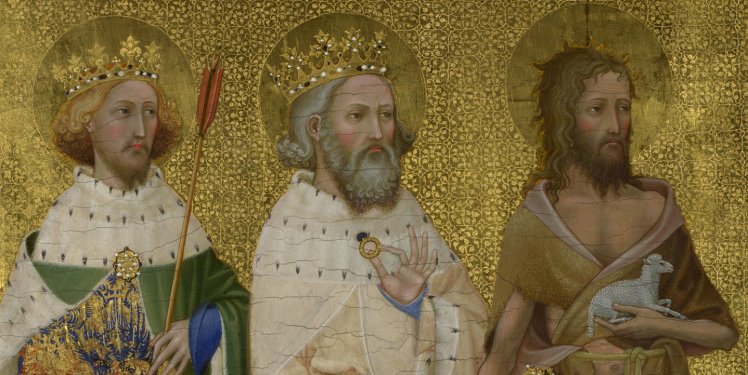
A very special treasure in the National
Gallery: the Wilton Diptych. It was painted c 1395 for Richard II, who
is shown kneeling on the left-hand panel with John the Baptist, his
patron saint, behind him, and two English king saints, Edward the
Confessor and Edmund the Martyr, behind him. The right-hand panel shows
the Virgin and Child surrounded by angels: the Christ-child is blessing Richard.
The diptych is hinged,
allowing it to be folded. It is thought to have been a portable
altarpiece for the king's private devotion. On the
reverse side are the royal arms, and a white hart, symbol of Richard.
The Diptych was once kept at Wilton House, in Wiltshire, hence its name.
Richard’s robe is made of
red vermillion fabric, and cloth of gold. The decoration provides the
certain identification of the king. The white hart is his personal
emblem, and the rosemary sprigs the emblem of his first wife, Anne of
Bohemia, who died in 1394, predating the painting of the diptych. Round
his neck is a gold collar. What look like pea-pods have been identified as
pods of the broom plant. Why? This becomes somewhat complicated.
The broom belongs to the
plant tribe known as the genista. Its early Latin name was planta
genista – rework this, and it becomes, perhaps surprisingly –
Plantagenet. Although the family did not adopt this name until the
fifteenth century, the symbol was in use in the twelfth century. Planta
Genista started as a nickname for Geoffrey, count of Anjou.
Broom pods were also the emblem of the French king Charles VI. Richard
married the six-year-old daughter of Charles, Isabella of Valois, in
1396, and this might be a reference to that connection.
Also round his neck is what can be described as
a necklace or badge, showing the white hart with antlers decorated with
pearls.

The saints.
The three saints are presenting Richard to the Virgin and child. John the Baptist is presented in the usual way; scruffy appearance, holding a lamb: 'Behold the Lamb of God'. Behind him in the white robe is Edward the confessor. He is holding his attribute, a finger ring. A legend tells us that a poor pilgrim begged the King for alms: having nothing to give him, he handed over the valuable ring from his finger. Later, another pilgrim returned the ring; he told Edward that the first pilgrim was, in fact, St John the Evangelist.
King Edmund carries an arrow, the symbol of his martyrdom.

The Virgin and child are surrounded by angels, eleven of them, which puzzles theologians as eleven has negative implications symbolically. Maybe the artist just couldn’t squeeze another one in. Each angel wears the white hart symbol of Richard. Their beautiful robes are painted with Lapis Lazuli, which underlines the importance (and expense) of the artwork.
A striking feature is the child-like appearance of Christ. This mirrors contemporary changes in Italian art, where the image of the Christ child has become more human and infant-like rather than appearing to be a small adult. There is also a range of expressions on the faces of the angels; one seems to be affectionately holding another around the shoulder.

Almost impossible to see is the small sphere on top of the staff. Recent restoration has revealed the image of an island, thought to be a map of England.

The rear or outer panels show for more wear than the front two. This is understandable, as the diptych would be closed for much of the time, and would be transported in this manner. On the right below is another white hart, relaxing in a flowery meadow. When originally painted it would have been much greener. On the left is the coat of arms of Richard II combined (or 'impaled' to use the correct heraldic term) with the imaginary coat of arms of Edward the Confessor showing five birds. The missing panels on the shield would have shown three lions. Above, difficult to see, is a crowned lion.
